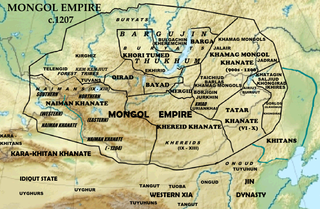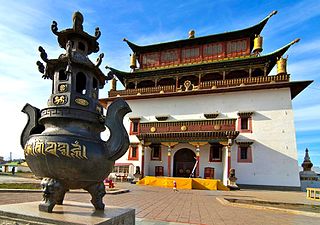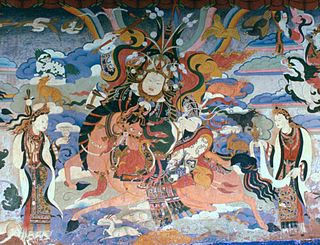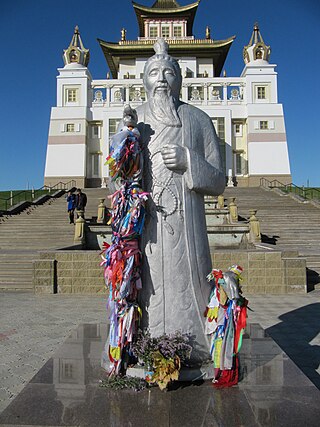Related Research Articles

The Mongols are an East Asian ethnic group native to Mongolia, Inner Mongolia in China, and the Buryatia Republic of the Russian Federation. The Mongols are the principal member of the large family of Mongolic peoples. The Oirats in Western Mongolia as well as the Buryats and Kalmyks of Russia are classified either as distinct ethno-linguistic groups or subgroups of Mongols.

The Buryats are a Mongolic ethnic group native to southeastern Siberia who speak the Buryat language. They are one of the two largest indigenous groups in Siberia, the other being the Yakuts. The majority of the Buryats today live in their titular homeland, the Republic of Buryatia, a federal subject of Russia which sprawls along the southern coast and partially straddles the Lake Baikal. Smaller groups of Buryats also inhabit Ust-Orda Buryat Okrug and the Agin-Buryat Okrug which are to the west and east of Buryatia respectively as well as northeastern Mongolia and Inner Mongolia, China. They traditionally formed the major northern subgroup of the Mongols.

Buryatia, officially the Republic of Buryatia, is a republic of Russia located in the Russian Far East. Formerly part of the Siberian Federal District, it has been administered as part of the Far Eastern Federal District since 2018. Its capital is the city of Ulan-Ude. It has an area of 351,300 square kilometers (135,600 sq mi) with a population of 978,588. It is home to the indigenous Buryats, who are the republic's titular nation.

A Borjigin is a member of the Mongol sub-clan, which started with Bodonchar Munkhag of the Kiyat clan. Yesugei's descendants were thus said to be Kiyat-Borjigin. The senior Borjigids provided ruling princes for Mongolia and Inner Mongolia until the 20th century. The clan formed the ruling class among the Mongols and some other peoples of Central Asia and Eastern Europe. Today, the Borjigid are found in most of Mongolia, Inner Mongolia and Xinjiang, and additionally genetic research has shown that descent from Genghis Khan and Amir Timur Barlas is common throughout Central Asia and other regions.

Buddhism is the largest religion in Mongolia practiced by 51.7% of Mongolia's population, according to the 2020 Mongolia census. Buddhism in Mongolia derives much of its recent characteristics from Tibetan Buddhism of the Gelug and Kagyu lineages, but is distinct and presents its own unique characteristics.

Tengrism is an ethnic Turkic, Yenisenian, Mongolic religion originating in the Eurasian steppes based on shamanism and animism. It is generally involves the titular sky god Tengri, who is not considered a deity in the usual sense, but a personification of the universe. According to some scholars, adherents of Tengrism view the purpose of life, to be in harmony with the universe.

Religion in Mongolia has been traditionally dominated by the schools of Mongolian Buddhism and by Mongolian shamanism, the ethnic religion of the Mongols. Historically, through their Mongol Empire the Mongols were exposed to the influences of Christianity and Islam, although these religions never came to dominate. During the communist period of the Mongolian People's Republic (1924–1992) all religions were suppressed, but with the transition to the parliamentary republic in the 1990s there has been a general revival of faiths.

The Kharchin, or Kharachin, is a subgroup of the Mongols residing mainly in North-western Liaoning and Chifeng, Inner Mongolia. There are Khalkha-Kharchin Mongols in Dorno-Gobi Province and in Ulaanbaatar, Mongolia.

The Mongol mythology is the traditional religion of the Mongols.

The Mongolic peoples are a collection of East Asian-originated ethnic groups in East, North, South Asia and Eastern Europe, who speak Mongolic languages. Their ancestors are referred to as Proto-Mongols. The largest contemporary Mongolic ethnic group is the Mongols. Mongolic-speaking people, although distributed in a wide geographical area, show a high genetic affinity to each other, and display continuity with ancient Northeast Asians.
Various nomadic empires, including the Xiongnu, the Xianbei state, the Rouran Khaganate (330–555), the First (552–603) and Second Turkic Khaganates (682–744) and others, ruled the area of present-day Mongolia. The Khitan people, who used a para-Mongolic language, founded an empire known as the Liao dynasty (916–1125), and ruled Mongolia and portions of North China, northern Korea, and the present-day Russian Far East.

The Mongols were highly tolerant of most religions during the early Mongol Empire, and typically sponsored several at the same time. At the time of Genghis Khan in the 13th century, virtually every religion had found converts, from Buddhism to Eastern Christianity and Manichaeanism to Islam. To avoid strife, Genghis Khan set up an institution that ensured complete religious freedom, though he himself was a Tengrist. Under his administration, all religious leaders were exempt from taxation, and from public service. Mongol emperors were known for organizing competitions of religious debates among clerics, and these would draw large audiences.

Mongolian shamanism, more broadly called the Mongolian folk religion, or occasionally Tengerism, refers to the animistic and shamanic ethnic religion that has been practiced in Mongolia and its surrounding areas at least since the age of recorded history. In the earliest known stages it was intricately tied to all other aspects of social life and to the tribal organization of Mongolian society. Along the way, it has become influenced by and mingled with Buddhism. During the socialist years of the twentieth century, it was heavily repressed, but has since made a comeback.
In the pantheon of Mongolian shamanism and Tengrism, tngri constitute the highest class of divinities and are attested in sources going back to the 13th century. They are led by different chief deities in different documents and are divided into a number of different groups—including black (terrifying) and white (benevolent), and eastern and western. While there generally seem to be 99 tngri, some documents propose three others, and while they are generally the highest divinities, some liturgical texts propose an additional group of 33 chief gods alongside the tngri. They were invoked only by the highest shamans and leaders for special occasions; they continue to be venerated especially in black shamanism. Chief among the tngri are Qormusata Tngri and (Khan) Möngke Tngri.

Tsagaan Ubgen is the Mongolian guardian of life and longevity, one of the symbols of fertility and prosperity in the Buddhist pantheon. He is worshiped as a deity in what scholars have called "white shamanism", a subdivision of what scholars have called "Buryat yellow shamanism"—that is, a tradition of shamanism that "incorporate[s] Buddhist rituals and beliefs" and is influenced specifically by Tibetan Buddhism. Sagaan Ubgen originated in Mongolia.
Dayan Deerh or Dayan Degereki is one of the most important divinities in the folk practices and shamanic invocations in Khövsgöl Province, Mongolia. His cult is linked to fertility rites which are practiced in yellow shamanism as well as in black shamanism. He is still venerated, especially on the eastern side of Lake Khövsgöl.
Black shamanism is a kind of shamanism practiced in Mongolia and Siberia. It is specifically opposed to yellow shamanism, which incorporates rituals and traditions from Buddhism. Black Shamans are usually perceived as working with evil spirits, while white Shamans with spirits of the upper world.
Ongon is a type of spirit in the shamanistic belief system of Mongolia. It is a common term in Mongol mythology. After death, all shamans become shamanic souls, ongod. Idols can be consecrated to them within three years of the shaman's death and can be placed in the home or in another locale, such as a shelter out in the open. The ongon is also the physical representation of that spirit, made by a shaman, which plays a central part in the ritual that invokes the protection of the spirit. One well-known such spirit is Dayan Deerh.

Sülde Tngri is an equestrian war god, one of the tngri, the highest group of divinities in Mongolian shamanism and Buddhism. He is usually depicted as an armored warrior riding a horse. In Mongolian shamanism, everyone possesses a guardian spirit, called a sülde. "Sülde Tngri" can refer to the sülde of any great leader, but it primarily refers to the deified sülde of Genghis Khan. As a war god, Sülde Tngri's primary function is protecting his devotees from their enemies and aiding them in battles against their foes.

Religion in Inner Mongolia is characterised by the diverse traditions of Mongolian-Tibetan Buddhism, Chinese Buddhism, the Chinese traditional religion including the traditional Chinese ancestral religion, Taoism, Confucianism and folk religious sects, and the Mongolian native religion. The region is inhabited by a majority of Han Chinese and a substantial minority of Southern Mongols, so that some religions follow ethnic lines.
References
Citations
Sources
- Hesse, Klaus (1987). "On the History of Mongolian Shamanism in Anthropological Perspective". Anthropos. 82 (4–6): 403–13. JSTOR 40463470.
- Мелетинский, Е.М. (1998). "ЦАГАН ЭБУГЕН". Мифология (4th ed.). Большая российская энциклопедия.
- Pegg, Carole (2001). Mongolian Music, Dance, & Oral Narrative: Performing Diverse Identities. University of Washington Press. ISBN 9780295981123 . Retrieved 13 August 2012.
- Shimamura, Ippei (2004). "Yellow Shamans (Mongolia)". In Walter, Mariko Namba; Neumann Fridman, Eva Jane (eds.). Shamanism. Shamanism: An Encyclopedia of World Beliefs, Practices, and Culture. Vol. 1. ABC-CLIO. pp. 649–651. ISBN 9781576076453.